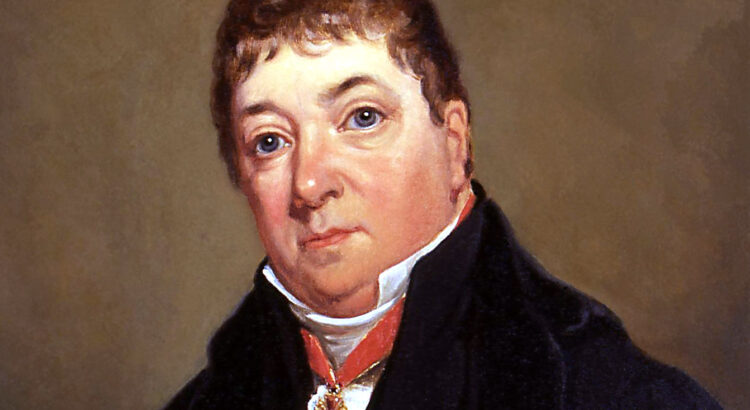In Dutch, we say that people who have a talent to learn languages have a ‘talenknobbel’, the same goes for a talent for math: a ‘wiskundeknobbel’. These expressions literally mean that someone with one of these talents has a bump on their head that shows their special ability. Long ago, in the 18th and 19th century, there was an actual science that analyzed the body of humans to look for indications of hiding talents or ‘bad qualities’. More on this cruel science called phrenology, and on how a skull of a soldier ended up in Rijksmuseum Boerhaave in Leiden can be read in the following blogpost.
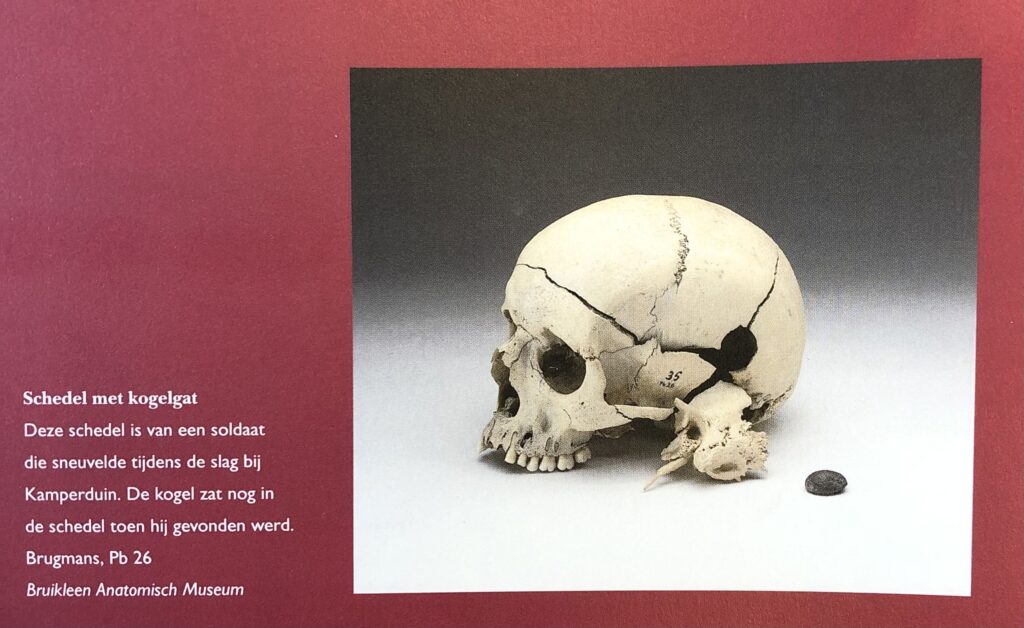
Translation of the text: ‘Skull with bullet hole. This skull is from a soldier who died at the battle of Camperdown. The bullet was still inside of the skull when it was found. Brugmans, Pb 26
The main object that will be discussed in this short biography is a skull of a soldier who died at the battle of Camperdown. This specific skull is part of the collection of Sebald J. Brugmans, former rector magnificus and professor in physics, philosophy and medicine at the university of Leiden. In addition, he even combined these jobs with being the director of the Hortus Botanicus of Leiden. The skull of the poor soldier is not the only human skull in the scientific collection of Brugmans, there are more than 120 other skulls to be found. The presence of these human artifacts points at the idea that Brugmans himself had some interest in phrenology as well. Later in this post I will elaborate more on the intriguing figure of Brugmans and his enormous collection, but first let us dive deeper in the so controversial science of phrenology.
The science on skull measurements
Phrenology finds its origin by the German scientist Franz Joseph Gall (1758-1828). This so-called pseudo-science involves the measuring of the human skull and brain, to show what kind of person you are dealing with. In the 18th and 19th century, another controversial science was becoming more popular too: the science of race. Racial anthropology and phrenology became intertwined and used techniques of each other intended to show alterations between different races. Phrenology was also used intended to show all kind of other differences by focusing on bumps on the skull and brains, the earlier mentioned Dutch ‘knobbels’. Phrenologists not only believed that these bumps showed revolutionary progress or special talents, it was also considered that ‘such traits — and their respective organs — could be modified through the practice of restraint or by the conscious “exercise” of a positive quality.’ In the database of the English Wellcome Collection, you can find a poster with different types of skulls and also famous historic figures. The poster seems to make you believe that these famous figures had some really special skulls (to which they might owe their fame).
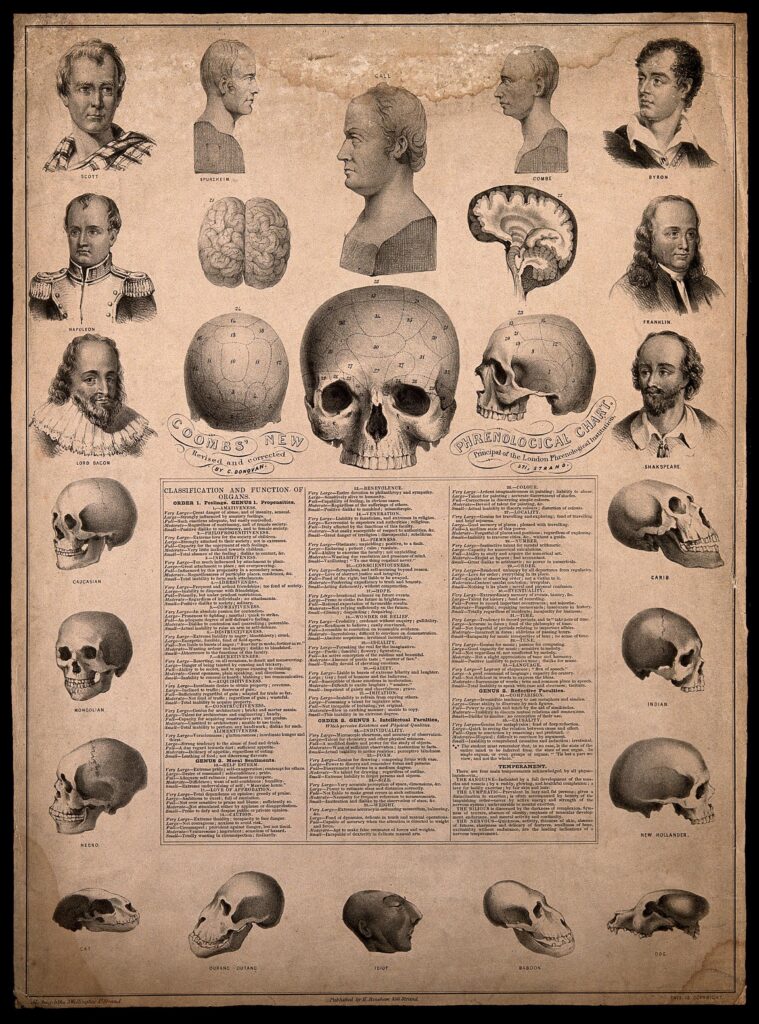
Phrenological chart with portraits of historical figures and illustrations of skulls exhibiting racial characteristics. Lithograph by G. E. Madeley, authored by C. Donovan, c. 1850.
Wellcome Collection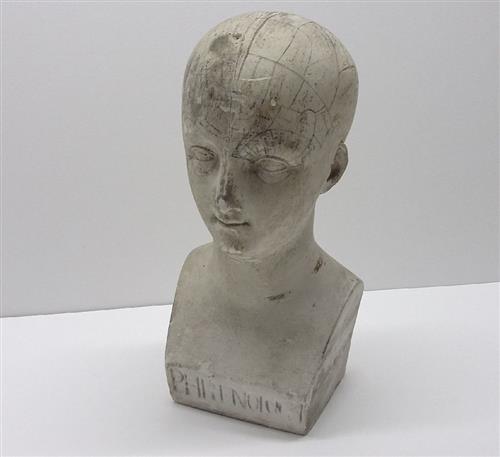
Plaster bust. On the right half of the skull is indicated the phrenology according to Gall, on the left which according to Johann Christoph Spurzheim (a pupil of Gall). Spurzheim got into a disagreement with Gall and went his own way.
Boerhaave collection
According to the catalogue provided by the exhibition on the Brugmans collection at Boerhaave museum in 2001, Brugmans was a follower of the science of Franz Joseph Gall. But, so the booklet mentions, he was a bit more moderate. Brugmans used to tell his students during anthropology class about an examination of a skull which indicated the brain of a genius. After opening the skull, the shape of the brains did not correspond with his presumption. According to Brugmans, this was not the skull of a genius, but one of a lunatic
For every lecture Brugmans gave to his students, he used objects out of his collection. Already short after his appointment to the university of Leiden, he began to collect all kinds of objects. He mainly started this because of the poor state the collection of curiosities of the university was in. At the end of his life, the Brugmans collection existed out of more than 4000 objects. It was one of a kind, and famous across the whole of Europe. Especially the selection of over 120 skulls. Brugmans did not only use these skulls to teach about phrenology, he also was very interested in pathology. That is why a huge part of the collection consists of skulls with all kinds of fractures or deformities. The professor got his hands on all these human artifacts during his time as inspector general at the military medical service. Soldiers who died in the military hospital had a big chance that part of their bodies ended up in the collection of Sebald Brugmans.
How a soldier ended up in a collection
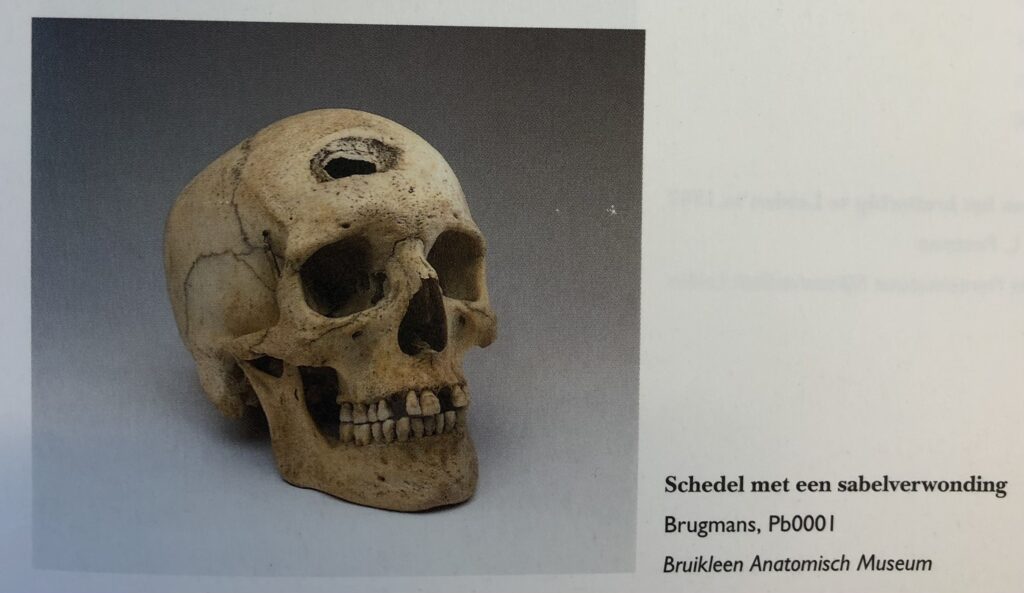
This procedure described above, is probably also the way the skull of the soldier who died at the battle of Camperdown got into the collection of Brugmans. The skull is fully intact except for the lower part of the temple, which broke off because of the hole the bullet made. Surrounding the bullet hole there are quite some cracks in the skull which seem to run entirely to the other side of the skull (see picture above). According to the catalogue of the exhibition, the bullet was still inside of the head of the soldier when the skull got collected. It is not known from what kind of weapon the bullet came that killed the soldier, but because of the size of the bullet I assume it was some sort of rifle or musket. Intriguing is the fact that Brugmans not only collected the skull, but that he conserved the bullet as well. Afterwards, presumably to identify and for organizational reasons, the code ‘35, Pb 26’ was written on the skull. Other skulls in the collection of Brugmans have similar codes written on them. For example, there is another skull with a saber injury that has Pb001 written on it.
After the death of Sebald Brugmans in 1819, his widow sold his collection to the university of Leiden for more than 34.000 Dutch Guilder. Soon after this, the collection fell apart into other different collections. Some objects found their way to the Anatomical Museum and the Boerhaave collection in Leiden, but the biggest part of the objects went to the ‘Rijksmuseum van Natuurlijke Geschiedenis’ (The Natural History Museum), which is nowadays know as Naturalis. In the process of the aforementioned exhibition in 2001 on the collection of Brugmans, researchers intensively looked into the collections of these museums to form a general overview of what the former professor had collected during his life. Back then, the skull of the soldier was part of the collection of the Anatomical Museum, but nowadays it can be found in the main exhibition at the Boerhaave museum. According to the collection, Sebald Brugmans was a very talented professor for his time and after all, would it not have been intriguing to see what kind of ‘knobbels’ such a skilled man had on his skull?
Written by Wiebe Reints
